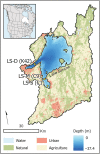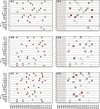Applying early warning indicators to predict critical transitions in a lake undergoing multiple changes
- PMID: 35633203
- PMCID: PMC9788049
- DOI: 10.1002/eap.2685
Applying early warning indicators to predict critical transitions in a lake undergoing multiple changes
Abstract
Lakes are dynamic ecosystems that can transition among stable states. Since ecosystem-scale transitions can be detrimental and difficult to reverse, being able to predict impending critical transitions in state variables has become a major area of research. However, not all transitions are detrimental, and there is considerable interest in better evaluating the success of management interventions to support adaptive management strategies. Here, we retrospectively evaluated the agreement between time series statistics (i.e., standard deviation, autocorrelation, skewness, and kurtosis-also known as early warning indicators) and breakpoints in state variables in a lake (Lake Simcoe, Ontario, Canada) that has improved from a state of eutrophication. Long-term (1980 to 2019) monitoring data collected fortnightly throughout the ice-free season were used to evaluate historical changes in 15 state variables (e.g., dissolved organic carbon, phosphorus, chlorophyll a) and multivariate-derived time series at three monitoring stations (shallow, middepth, deep) in Lake Simcoe. Time series results from the two deep-water stations indicate that over this period Lake Simcoe transitioned from an algal-dominated state toward a state with increased water clarity (i.e., Secchi disk depth) and silica and lower nutrient and chlorophyll a concentrations, which coincided with both substantial management intervention and the establishment of invasive species (e.g., Dreissenid mussels). Consistent with improvement, Secchi depth at the deep-water stations demonstrated expected trends in statistical indicators prior to identified breakpoints, whereas total phosphorus and chlorophyll a revealed more nuanced patterns. Overall, state variables were largely found to yield inconsistent trends in statistical indicators, so many breakpoints were likely not reflective of traditional bifurcation critical transitions. Nevertheless, statistical indicators of state variable time series may be a valuable tool for the adaptive management and long-term monitoring of lake ecosystems, but we call for more research within the domain of early warning indicators to establish a better understanding of state variable behavior prior to lake changes.
Keywords: critical transitions; early warning indicators; invasive species; management actions; resilience indicators.
© 2022 The Authors. Ecological Applications published by Wiley Periodicals LLC on behalf of The Ecological Society of America.
Conflict of interest statement
The authors declare that they have no known competing financial interests or personal relationships that could have appeared to influence the work reported in this paper.
Figures




References
-
- Batt, R. D. , Brock W. A., Carpenter S. R., Cole J. J., Pace M. L., and Seekell D. A.. 2013. “Asymmetric Response of Early Warning Indicators of Phytoplankton Transition to and from Cycles.” Theoretical Ecology 6: 285–93. 10.1007/s12080-013-0190-8. - DOI
-
- Beisner, B. E. , Haydon D. T., and Cuddington K.. 2003. “Alternative Stable States in Ecology.” Frontiers in Ecology and the Environment 1(7): 376–82. 10.1890/1540-9295. - DOI
-
- Bestelmeyer, B. T. , Ellison A. M., Fraser W. R., Gorman K. B., Holbrook S. J., Laney C. M., Ohman M. D., et al. 2011. “Analysis of Abrupt Transitions in Ecological Systems.” Ecosphere 2(12): 1–26. 10.1890/ES11-00216.1. - DOI
-
- Buelo, C. D. , Carpenter S. R., and Pace M. L.. 2018. “A Modeling Analysis of Spatial Statistical Indicators of Thresholds for Algal Blooms.” Limnology and Oceanography Letters 3(5): 384–92. 10.1002/lol2.10091. - DOI
-
- Burthe, S. J. , Henrys P. A., Mackay E. B., Spears B. M., Campbell R., Carvalho L., Dudley B., et al. 2016. “Do Early Warning Indicators Consistently Predict Nonlinear Change in Long‐Term Ecological Data?” Journal of Applied Ecology 53(3): 666–76. 10.1111/1365-2664.12519. - DOI
Publication types
MeSH terms
Substances
Associated data
LinkOut - more resources
Full Text Sources
Miscellaneous

